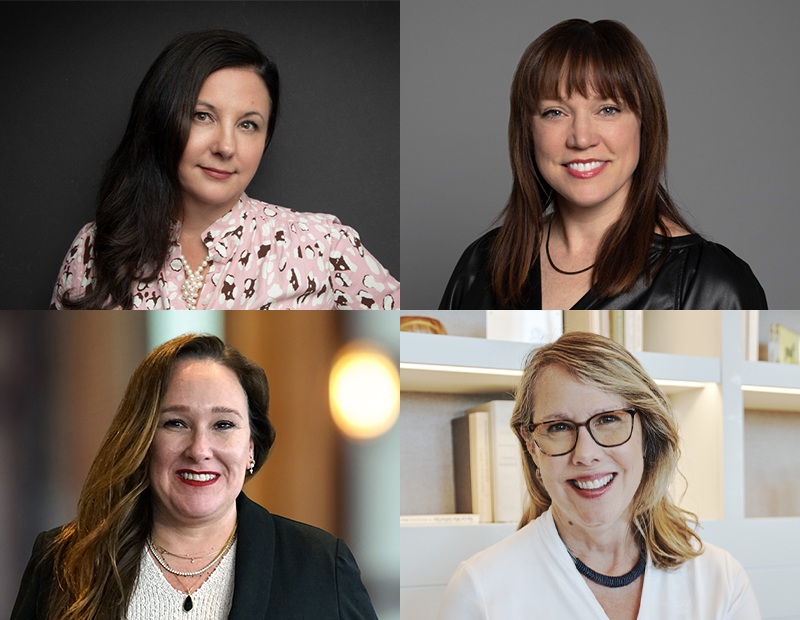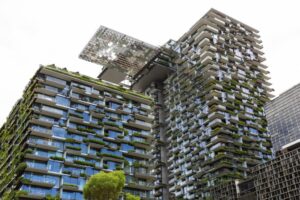Office Design Trends: What’s In, What’s Out?

Office design is constantly evolving, reflecting broader dynamics in how we work, where we work and even how work impacts us.
As hybrid models, employee well-being and sustainability continue to be center stage, many traditional office elements are quickly fading, and more adaptive, people-centric solutions are emerging. Companies are rethinking their workspaces entirely, so certain layouts and materials are being abandoned and replaced by more compelling, yet functional and eco-conscious alternatives.
From cubicles to community
The first major shift we’ve seen in modern office design is the demise of cubicles and closed-off spaces. Historically designed for efficiency, cubicles and individual workstations have been the default layout for decades. But as workplaces embrace adaptability, these once ubiquitous fixtures are making their exit.
Rigid, impersonal cubicles are a thing of the past, with flexible, dynamic spaces that prioritize interaction and collaboration taking over, HLW Principal Cristen Colantoni told Commercial Property Executive. KTGY Associate Principal Sara Talleux also noted that traditional cubicles are being replaced with collaborative spaces to reflect the ongoing shift toward hybrid work models.
READ ALSO: How Neurodivergent-Friendly Office Design Can Benefit Everyone
Similarly, Janet Pogue McLaurin, global director for workplace research at Gensler, has seen that sterile, closed-off environments that create stark, anti-septic workplaces are increasingly being replaced with once uncommon trends like biophilia or hospitality-infused places.
Offices are now designed to be more inviting, comfortable and people-focused. This includes the introduction of communal areas like lounges and cafés that encourage informal collaboration and socialization, fostering a sense of community. In many cases, this shift extends beyond the walls of the office, as companies explore using outdoor gardens, light-filled solariums and other natural environments to boost creativity and well-being.
No more cold aesthetics
Another key aspect of office design that’s fading away is the minimalist, industrial aesthetic that dominated many offices in the past. Gone are the days of all-white spaces that created cold, impersonal atmospheres. Today, the office is about bold and creative approaches that reflect a company’s culture and values, according to Colantoni.
Tenants are moving away from neutral palettes, favoring vibrant colors, warmer materials and natural elements that create a welcoming, residential-like feel, noted KTGY Principal Gina Deary. The coldness of laminate and vinyl is also being replaced by eco-friendly materials like reclaimed wood and recycled content, as reducing the carbon footprint gets higher on both developers’ and landlords’ priority list.
Sustainability at the forefront
From just a buzzword a few years ago, sustainability has become a core consideration in office design.
“Clients are striving to align their climate commitments with their real estate,” said McLaurin. They are no longer interested in abstract notions of sustainability, seeking real, measurable outcomes.
And this focus on sustainability extends beyond materials. Offices are now designed to support energy efficiency and reduce waste, while circular design practices are becoming more prominent, Deary noted. These approaches not only benefit the planet but also resonate with employees who value companies that take their environmental responsibilities seriously.
The wellness imperative
Furthermore, sustainability brings benefits to employees’ overall well-being, too. Recently, there’s been an increased focus on wellness and creating spaces that support employees’ health. This has changed office design in meaningful ways, believes Colantoni, who has noticed an inclination toward designs that incorporate natural elements such as plants, more light and mostly organic materials. All these features contribute to increasing the air quality in the office, while reducing stress and enhancing productivity, ultimately creating healthier work environments.
“There’s a shift to a more holistic approach to health by also providing outdoor workspaces, spaces to connect, reflect, refresh and recharge for mental and social well-being,” McLaurin added.
An increasing number of offices now include gardens, outdoor breakout spaces and quiet zones where employees can disconnect for a short time during the workday.
More customization
To meet employees’ high expectations, flexibility has become the cornerstone of modern office design. Universal planning or one-size-fits-all approaches are falling out of favor, according to McLaurin, with offices increasingly designed to be compelling destinations that offer a variety of experiences and cater to the needs of diverse workforces.
In the hybrid era, employees want different types of spaces for various activities, from quiet zones for deep work to open areas for collaboration. Colantoni noted that today’s offices need to offer a mix of shared desks, activity-based workspaces, open teamwork areas, quiet zones and private rooms, giving employees the choice and flexibility to work in ways that best suit their tasks. Workplaces now need to offer a variety of work points with “degrees of openness” to support the new ways of working, McLaurin pointed out.
This shift is particularly evident in the rise of modular furniture and adaptable spaces. Heavy, bulky furniture is being replaced by flexible pieces that support mobility and unique task requirements, according to Deary. This allows spaces to be reconfigured quickly for different needs, from meetings to solo work or impromptu collaboration sessions.
Tech-driven spaces for hybrid work
Technology integration also plays a pivotal role in shaping office design trends, especially as remote work remains a significant part of the work culture. Offices are no longer just physical locations but technology-enabled spaces that facilitate collaboration between in-person and remote teams.
“Seamless and integrated technology is critical,” Talleux said.
Tech solutions that support collaboration—from video conferencing setups, digital whiteboards and collaborative software to movable lockers for shared spaces—are no longer a nice-to-have office amenity.
Furthermore, incorporating IoT devices and smart technology will create more efficient workspaces, Deary said. Automated lighting, climate control and desk-booking systems are just some of the tech advancements that enable flexibility and improve the overall employee experience.
The future is always in beta
And as work patterns continue to evolve, so are office design trends. According to McLaurin, the future workplace is “always in beta,” meaning it constantly pilots new ideas, tests solutions and gathers feedback to remain flexible and responsive to the needs of its users.
The office of the future will blend design, technology and wellness into a cohesive, dynamic space that can accommodate the rapidly shifting demands of the workforce.
“The best workplaces will be designed for ever-evolving change,” McLaurin concluded.
The post Office Design Trends: What’s In, What’s Out? appeared first on Commercial Property Executive.




